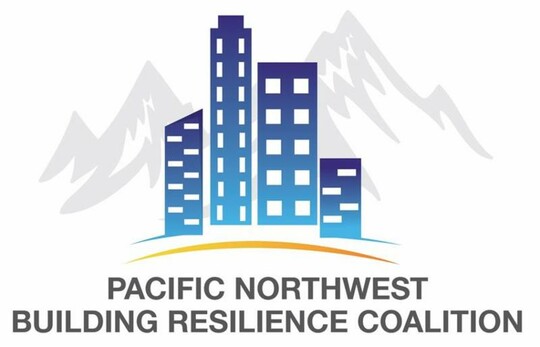The better a structure is built, the longer it will last and the more resilient it will be to the elements. Building strategically using strong, longstanding materials leads to safety, sustainability, and cost-efficiency. As a building material, concrete possesses these qualities and performs incredibly.
Resiliency
Pacific Northwest Building Resilience Coalition

Concrete Alberta is committed to spreading the word about the benefits of building resiliency and are proud to be a part of the Pacific Northwest Building Resilience Coalition.
The Pacific Northwest Building Resilience Coalition represents thousands of private companies committed to improve planning, development, and the construction of homes, buildings, communities, and associated infrastructure capable of surviving, recovering from, and adapting to the growing impacts of natural disasters, climate change, and an ever-evolving urban and physical environment.
Webinars
In collaboration with the Pacific Northwest Economic Region (PNWER), the Pacific Northwest Building Resilience Coalition produced a series of webinars, Pathway to Resilience and Carbon Neutrality, focused on Achieving Resilience and Climate Targets, making transparent the Cement, Concrete and Masonry Industry’s Pathway to Carbon Neutrality. These webinars brought together six of the world’s leading experts to address how we must build economies and infrastructures in clean, safe and, above all, resilient ways.
Webinar 1: Building the Future – What, How, and What From
Featuring Dr. Andrew Minson, Concrete and Sustainable Construction Director, Global Cement and Concrete Association, explores how construction practices in the future will affect what we build and how we build and what must the cement and concrete industries do to reduce CO2 and GHG emissions to address the impacts of climate change.
Webinar 2: The Roadmap to Carbon Neutrality
Featuring Richard Bohan – Vice President, Sustainability, Portland Cement Association, explores sustainability-related activities in the Association’s recently published Roadmap to Carbon Neutrality.
Webinar 3: Decarbonizing Concrete – The Policy Levers
Featuring Adam Auer, then Vice President and now President and CEO of the Cement Association of Canada, examines the entire built environment value chain from a circular economy perspective and outlines the low-Carbon Procurement Policies and Incentives needed for the future.
Webinar 4: Concrete Innovations – the Environmental Impacts of Building Materials
Featuring Tien Peng, Senior Vice President of Sustainability, Codes and Standards, National Ready Mixed Concrete Association, discusses current and future innovations of concrete that policymakers and design professionals should consider as they assess the environmental impacts of building materials to maximize resilience, performance and deliver lasting value.
Webinar 5: Concrete as a sustainability solution
Featuring Dr. Randolph E. Kirchain, Ph.D.., Co-Director of the Concrete Sustainability Hub at the Massachusetts Institute of Technology, goes far beyond the use of concrete in construction and explores reducing emissions on our roads through greater fuel efficiency, using the thermal mass for heating/cooling our buildings, and the reflective characteristics of concrete. It also involves the natural reuptake of CO2 by exposed concrete surfaces to “permanent sequestration” of carbon dioxide.
Featuring Evan Reis, Co-Founder and Executive Director, U.S. Resiliency Council, explores the need for policies and incentives that promote resilience-based methods to ensure a more resilient future.
The Importance of Building Resiliency
Why does resiliency matter? MIT research has highlighted some major findings around why building with resiliency in mind really matters:
- Saving governments rebuilding costs after extreme weather situations.
- Protect against tragedy before storms strike by using resilient materials like concrete.
- Save costs in the long run, even if the initial investment is slightly higher:
- MIT has developed what they call a Break Even Mitigation Percent (BEMP) model that can help contractors and engineers to determine how much they could save by investing in resilient building practices.
- In USD, MIT determined that a $340,000 investment in hazard mitigation could pay for itself in the lifetime of a $10 million building.
Learn more about how building strong, innovative structures can help protect from the negative effects of climate change from the Intact Centre on Climate Adaptation.
Economic & Environmental Benefits of Disaster Resilient Design
Evan Reis, U.S. Resiliency Council, discusses the impact of changing climatic conditions and extreme weather events and the importance of resilient design in reducing the catastrophic impacts.
PNWER Summit
PNWER Summit 2018
Video: Resiliency in the Public Sphere
Featuring Evan Reis, Executive Director and Co-founder of the U.S. Resiliency Council addressed attendees of the PNWER 2018 Summit addressing the steps that communities and leaders can take to strengthen their resilience in the wake of natural disasters.
Concrete Alberta was a proud sponsor of this keynote through our involvement with the Pacific Northwest Building Resilience Coalition.
Other Resources
Extreme Weather: Why We Must Adapt
The following video features Dr. Blair Feltmate, Head of the Intact Centre on Climate Adaption at the University of Waterloo, speaking about climate change and adaptation in a panel session organized by the Cement Association of Canada.
Resilience: Adapting to Climate Change
The following video features Dr. Blair Feltmate, Head of the Intact Centre on Climate Adaption at the University of Waterloo discusses the need for infrastructure to be resilient in the face of climate change.